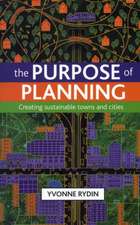Transformation of Cities in Central and Eastern Europe: Towards Globalization
Editat de F.E. Ian Hamilton, Kaliopa Dimitrovska Andrews, Natasa Pichler-Milanovicen Limba Engleză Paperback – 7 noi 2005
This book identifies and describes the inter- and intra-urban transformations of Central and Eastern European cities. The authors discuss the similarities and differences between significant Central and Eastern European cities, comparing patterns of historical context and socialist legacies before 1990, and the impacts of internal and external forces on reshaping the cities since then. These themes are explored through case studies of capital cities in Central Europe (Berlin, Budapest, Prague, Ljubljana, and Warsaw), the Baltic States (Tallinn, Riga, and Vilnius), Southeast Europe (Sofia) and Eastern Europe (Moscow).
Preț: 415.37 lei
Nou
Puncte Express: 623
Preț estimativ în valută:
79.48€ • 82.82$ • 65.81£
79.48€ • 82.82$ • 65.81£
Carte tipărită la comandă
Livrare economică 03-17 aprilie
Preluare comenzi: 021 569.72.76
Specificații
ISBN-13: 9789280811056
ISBN-10: 9280811053
Pagini: 536
Dimensiuni: 156 x 235 x 30 mm
Greutate: 1.14 kg
Editura: Brookings Institution Press
Colecția United Nations University Press
Locul publicării:Japan
ISBN-10: 9280811053
Pagini: 536
Dimensiuni: 156 x 235 x 30 mm
Greutate: 1.14 kg
Editura: Brookings Institution Press
Colecția United Nations University Press
Locul publicării:Japan
Notă biografică
F. E. Ian Hamilton a senior lecturer in the Department of Geography and Environment at the London School of Economics and Political Science. Kaliopa Dimitrovska Andrews is director of the Urban Planning Institute of the Republic of Slovenia. Natasa Pichler-Milanovic is a research fellow at the Urban Planning Institute of the Republic of Slovenia and at the London School of Economics and Political Science.
Descriere
This book identifies and describes the inter- and intra-urban transformations of Central and Eastern European cities. The authors discuss the similarities and differences between significant Central and Eastern European cities, comparing patterns of historical context and socialist legacies before 1990, and the impacts of internal and external forces on reshaping the cities since then. These themes are explored through case studies of capital cities in Central Europe (Berlin, Budapest, Prague, Ljubljana, and Warsaw), the Baltic States (Tallinn, Riga, and Vilnius), Southeast Europe (Sofia) and Eastern Europe (Moscow).















